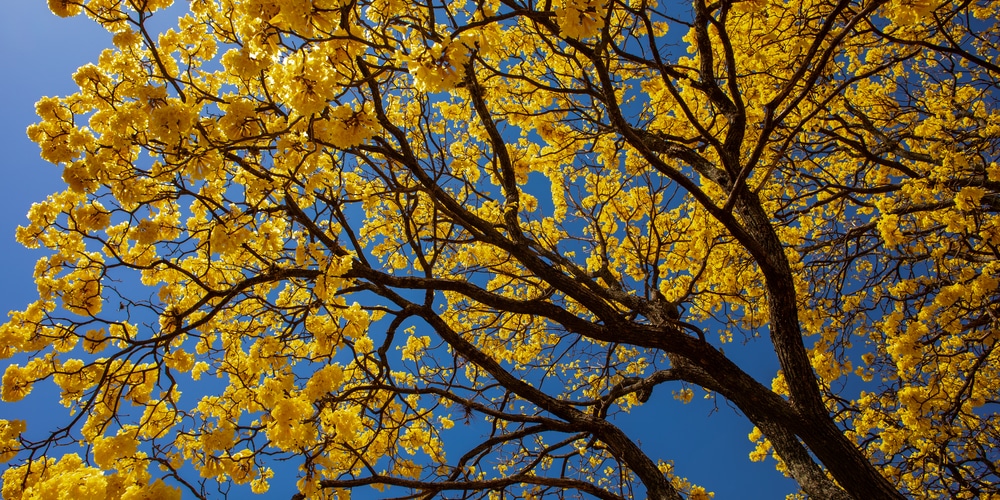The Tabebuia is a genus of flowering trees with trumpet or bell-shaped flowers.
| Botanical Name | Tabebuia |
| Common Name | Trumpet Tree, Tree of Gold |
| Plant Type | Perennial |
| Flower Color | Tubular clusters of yellow blooms |
| Size When Mature | 240 to 360 inches |
| Bloom Time | Spring and Summer |
| Sun Requirements | Full sun or partial shade |
| USDA Hardiness Zones | 9 to 11 |
| Soil PH Range | 5.5 to 8 |
| Soil Type | Rich, well-draining |
| Water Needs | Medium |
| Native Area | Mexico, Caribbean |
What you Need to Know About The Tabebuia Tree
The Tabebuia tree, otherwise known as Trumpet tree, encompasses more than a hundred different varieties both majestic and small. Some will reach up to 150 feet while others max out at 25 feet.
The star of the Tabebuia tree is the golden yellow flowers that appear during the spring and summer seasons. The tree’s crown is bedecked with innumerable flowers that are shaped like trumpets and grouped in bouquets. The colorful show lasts throughout spring and sometimes extends to summer. In other tabebuia varieties the flowers are red, magenta or white.
The Trumpet tree is easy to care for, but keep in mind that the plant requires a warm environment and regular pruning. Other than that, you can just sit back, wait, and watch as your Tabebuia explodes in a golden shower to signal the arrival of spring.
How to Care for the Tabebuia Plant
Here’s everything you need to know about growing and caring for a thriving Tree of Gold
Light
Full sunlight is a requirement to see the spectacular golden flowers the tree is famous for. A spot that gets anywhere between 8 to 12 hours of direct light is a good place to start. The Tabebuia tree thrives in a warm environment and unfiltered sunlight, rewarding you with long-lasting blooms that turn into seed pods in winter.
The Tabebuia tree is fairly adaptable to partial sun, where it gets four to six hours of sun per day. It’s worth noting that most tabebuia plants will have more or less the same light requirements as mentioned.
Water and Soil Needs
Nearly any type of soil can be used for the tree of gold. The Tabebuia can tolerate loamy, sandy, or even heavy clay, although the best medium is fertile soil that has plenty of organic matter, such as aged compost and mulch. What’s important is that the soil shouldn’t retain too much water to prevent waterlogging and rotted roots.
Watering a young tabebuia tree should be done regularly and in the first few months. Once planted, keep the soil moist and water more during the summer season. After a year has passed, you can reduce the frequency to about once every week or so and allow the rain to do the rest. Remember to water deeply and along the drip line so your Tabebuia gets nicely hydrated.
Temperature Requirements
The Trumpet tree can grow in USDA zones 9 through 11 and in regions that do not get a hard frost. It simply won’t survive in lower and colder zones outside- in some cases, you can grow the Tabebuia in a container and bring the plant indoors to overwinter and protect against the freeze.
A warm environment is a specific requirement to grow the Tabebuia tree. They’re sensitive to cold but are carefree yard or garden landscape specimens in areas that get consistently high temperatures.
Fertilizer
The best fertilizer to use on a Tabebuia tree is a balanced feeding mix designed to support the tree’s early growth.
Generally speaking, Trumpet trees do not require fertilization upon maturity. However, you can make your plant grow strong and healthy while it’s still young with a balanced fertilizer mix during the growing season. Too much can limit flower production in favor of foliage, so apply only once or twice during spring and early fall.
Alternatively, you can give your plant a slow-release formula in the first few months after transplanting. In addition, you will need to prune your Tabebuia regularly to keep a neat appearance and to promote healthy growth.
Common Diseases
The Tabebuia tree is unaffected by most pests and diseases. You’ll find that the only problem with the Tree of Gold is fungal diseases, caused by overwatering. You can easily remedy this by keeping the soil moist but not waterlogged and checking the surface before reaching for the hose.
You can avoid tree branches rubbing against each other and overcrowding by cutting away dead branches and leaves throughout the growing season.
Tabebuia Tree Propagation
You can propagate your Trumpet tree using hardwood cuttings or seeds.
For seed propagation, you can collect specimens when the pods dry and begin to open. Sow the seeds into a well-draining medium about a half-inch in, then water thoroughly. Keep the medium slightly moist and wait for leaves to appear. You can transplant it to its final location once the seedling reaches about 18 inches in height.
The best time to take hardwood cuttings is at the start of spring and when temperatures begin to rise. Select a specimen that’s around 12 inches, with branches that are an inch or two thick. Scratch the bark at the bottom area lightly and add some rooting hormone if you want. Plant the cutting in a pot and keep the well-draining soil moist until you see roots.
After 2-3 months you can transplant the cutting to its final spot or container.

